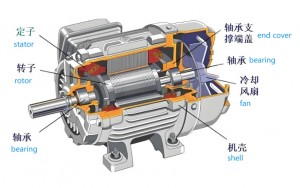Porosity excursion is a serious phenomenon that can severely impact the performance and life of an electric motor. It refers to the unwanted movement of air or other material through the motor pores, which can cause a variety of operating problems. Understanding the causes of porosity excursion is critical to maintaining motor efficiency and preventing serious damage. This article explores several key factors that cause porosity excursion, including bearing damage, rotor shaft bending, installation problems, and foreign material intrusion.
A. Bearing damage and severe wear
One of the main causes of bore misalignment during motor operation is damaged or severely worn bearings. Bearings are critical components that support the rotor and allow it to rotate freely. Damaged or excessively worn bearings can cause rotor misalignment. This misalignment creates gaps that allow air and foreign matter to enter the motor’s internal components, causing bore misalignment. The presence of foreign particles can increase bearing wear, creating a vicious cycle of damage.
B. Rotor shaft bending
Another significant contributor to bore misalignment is rotor shaft bending. When a rotor shaft is overloaded or misaligned, it bends, causing uneven spacing between the rotor and stator. This bending creates gaps that allow air and contaminants to infiltrate the motor. The resulting bore misalignment can lead to further mechanical problems, including increased vibration and noise, and ultimately, bearing system failure.
C. End cover installation problem
Porosity can also result from improperly installed end caps. End caps act as a protective barrier that seals the motor’s internal components. If the end caps are not installed correctly, openings can be created that allow foreign matter to enter the air gap between the stator and rotor. This intrusion can interfere with the operation of the motor, causing inefficiencies and potentially damaging the bearing system. Ensuring that the end caps are properly installed is critical to preventing porosity and maintaining motor integrity.
D. There is foreign matter in the gap between the stator and the rotor
The presence of foreign matter in the gap between the stator and rotor is a significant contributor to porosity. Dust, debris, and other contaminants can accumulate in this space, causing increased friction and wear on the rotor and stator surfaces. This accumulation also creates an environment that favors porosity because foreign matter disrupts airflow and creates pressure differentials that draw air and other contaminants into the motor. Regular maintenance and cleaning are essential to minimize the risk of foreign matter accumulation.
E. Foreign matter enters the air gap
In addition to the gap between the stator and rotor, foreign matter can enter the air gap in a variety of ways, including inadequate sealing and ventilation issues. When foreign particles penetrate the air gap, they can cause severe damage to the motor’s internal components, leading to bearing system failures and other mechanical problems. Implementing effective sealing solutions and ensuring proper ventilation can help reduce the risk of foreign matter entering the air gap.
F. Axis Fission
Finally, shaft fission, or rotor shaft fracture, can also cause bore misalignment. This phenomenon can occur due to excessive stress or fatigue on the rotor shaft, leading to catastrophic failure. When shaft fission occurs, large gaps are created that allow air and contaminants to enter the motor, exacerbating bore misalignment issues. Regular inspection and monitoring of the condition of the rotor shaft is essential to prevent this serious problem.
Bore excursion during motor operation is a multifaceted problem that can be caused by a variety of factors, including bearing damage, rotor shaft bending, installation issues, and foreign material intrusion. Understanding these causes is critical to implementing an effective maintenance strategy and ensuring the life and efficiency of the three phase asynchronous motor. By proactively addressing these issues, operators can minimize the risk of bore excursion and its associated consequences, ultimately improving motor performance and reliability.
Post time: Dec-06-2024


